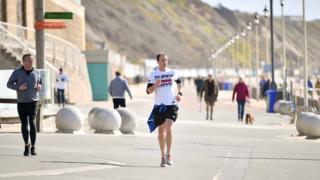 Image copyright
PA Media
Image copyright
PA Media
With warm weather forecast in parts of the UK over Easter, the government has appealed for people to stick to the restrictions on movement.
These say people should go out as little as possible and only leave if they have a "reasonable excuse". This includes:
- Exercise - alone, or with members of your household
- Shopping for basic necessities
- Any medical need, or providing care for a vulnerable person
- Travel to or from work, but only when you cannot work from home
What are the rules on exercise?
If you have to go outside you should stay more than 2m (6ft) apart from anyone other than members of your own household. This is what's known as social distancing.
No mention is given to how long you can exercise for. But Cabinet Office minister Michael Gove has said: "I would have thought for most people a walk of up to an hour, a run of 30 minutes or a cycle ride of between that, depending on their level of fitness, is appropriate."
Health Secretary Matt Hancock has said sunbathing during warmer weather was against social distancing rules. Labour's new deputy leader Angela Rayner said it was "all right for people who have got big houses and huge back gardens" to tell people to stop sunbathing.
Police have wide-ranging powers to help fight coronavirus by enforcing social distancing measures.
With temperatures forecast to reach 25C (77F) over Easter, some police forces have warned of a crackdown on people flouting the rules.
Why is social distancing necessary?
Social distancing is important because coronavirus spreads when an infected person coughs small droplets - packed with the virus - into the air.
These can be breathed in, or can cause an infection if you touch a surface they have landed on, and then touch your face with unwashed hands.
What is self-isolation?
If you show symptoms of coronavirus - such as a dry cough and high temperature - you must take extra precautions.
You should stay at home and if possible, not leave it for any reason.
This is known as self-isolation.
If possible, you should not go out even to buy food or other essentials. If you are unable to get supplies delivered, you should do what you can to limit social contact when you do leave the house.
Who should self-isolate?
Everyone who shows coronavirus symptoms - a fever of above 37.8C, a persistent cough or breathing problems - and everyone who lives in the same house or flat as someone with symptoms.
- If you live alone, you must stay at home for seven days from the day symptoms start
- If you, or someone you live with, develop symptoms, the entire household needs to isolate for 14 days to monitor for signs of Covid-19
- If someone else does become ill during that period, their seven-day isolation starts that day. For example, it might run from day three to day 10 - when that person's isolation would then end. It would not restart if another member of the household fell ill
- But anyone who fell ill on day 13 would have to start a separate seven-day isolation from that day (meaning they would spend a total of 20 days at home)
The person with the symptoms should stay in a well-ventilated room with a window that can be opened, and keep away from other people in the home.
People are being advised not to ring NHS 111 or their GP to report their symptoms unless they are worried.
Who shouldn't go out at all?
About 1.5 million people with very serious health conditions are being contacted by the NHS and urged not go out at all for at least 12 weeks.
This is what's known as shielding.
The most vulnerable group includes:
- Certain types of cancer patients
- Organ transplant patients
- People with certain genetic diseases
- People with serious respiratory conditions such as cystic fibrosis and severe chronic bronchitis
- People receiving certain drug treatments which suppress the immune system
- Pregnant women with heart disease
The government says it will work with local authorities, supermarkets and the armed forces to ensure they get supplies of essential food and medicines.
Others in the same household, and carers, can go out as long they observe proper social distancing.